| AUGUST 2016 |
|
6 shows in T˘ky˘ (Kabukiza, National Theatre, National N˘ Theatre), 1 in Nagoya (Chűnichi Theatre), 2 in ďsaka (National Bunraku Theatre, Kintetsu Art Kan)!
|
| Kabukiza (T˘ky˘) |  |
| Dates | 9 ~ 28 August 2016 (Hachigatsu N˘ry˘ Kabuki) August Cool-Breeze Kabuki |
| MatinÚe | |
| Afternoon |
Iro Momiji Tsugiki no Futsutsuka (Benikan) T˘kaid˘chű Hizakurige |
| Evening |
Kuruwa Banashi Yamanaya Urazato |
| Casting |
Nakamura Hashinosuke, Ichikawa Ennosuke, Nakamura Senjaku, Nakamura Kankur˘, Nakamura Shichinosuke, Band˘ Yajűr˘, Ichikawa Somegor˘, Nakamura Shid˘, Kataoka Kamez˘, Ichikawa Ukon, Band˘ Takesabur˘, Ichikawa Komaz˘, Ichikawa Monnosuke, Ichikawa Emisabur˘, Ichikawa Emiya, Band˘ Shűch˘, Matsumoto Kingo, Sawamura S˘nosuke, Ichikawa Juen, Nakamura Kazutar˘, Nakamura Kamenoj˘, Band˘ Minosuke, Nakamura Kotar˘, ďtani Hirotar˘, Band˘ Shingo, Nakamura Kunio, Nakamura Muneo, Nakamura Yoshio, Matsumoto Kintar˘, Ichikawa Danko, Namino Noriyuki, Suruga Tar˘ |
| Comments |
The usual summer program at the Kabukiza! It is entitled Hachigatsu N˘ry˘ Kabuki (literally "the August cool-breeze Kabuki"). This is the first stage appearance (omemie) of Nakamura Kankur˘'s second son Namino Noriyuki, who plays the role of a little page in the dance-drama "Tsuchi-gumo".
|
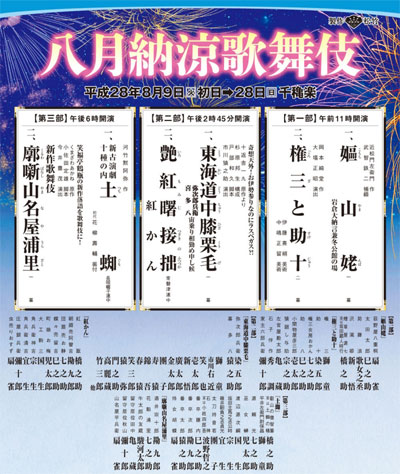 |
|
|||
| Dates | 4 ~ 7 August 2016 (Ichikawa Ebiz˘ Tokubetsu K˘en) Ichikawa Ebiz˘ Special Performances |
||
| Program | |||
| Kabuki Casting |
Ichikawa Ebiz˘, Kataoka Ichiz˘, Ichikawa Unosuke, Ichikawa Kudanji, ďtani Hiromatsu, Katayama Kur˘emon, Kanze Yoshimasa, Anthony Roth Costanzo, Shigeyama Ippei, Ichikawa Botan |
||
| Comments |
A special program mixing Kabuki, N˘ and Opera. The young heir of the Naritaya guild performs in a special version of "Genji Monogatari", featuring the N˘ actors Katayama Kur˘emon X and Kanze Yoshimasa, and the Opera Countertenor Anthony Roth Costanzo. The script for this version of "Genji Monogatari" focuses on the story from Oborozukiyo to Suma/Akashi.
|
||
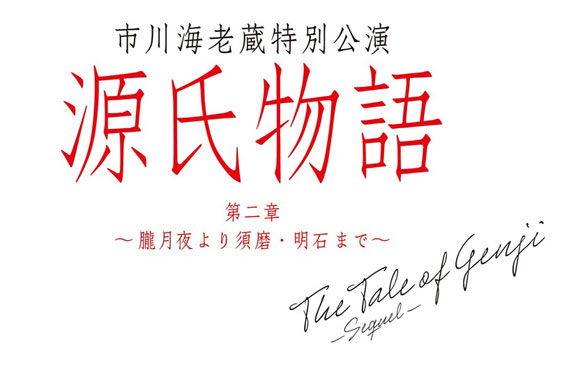 |
| National Theatre (T˘ky˘) |
| Dates | 6 ~ 7 August 2016 (Ken no Kai) |
| Program |
|
| Casting |
Onoe Ukon, Ichikawa Somegor˘, Kamimura Kichiya, Nakamura Yonekichi, Nakamura Tanenosuke, Nakamura Takanosuke, Ichimura Kitsutar˘ |
| Comments |
2nd edition of the Ken no Kai, which stars Onoe Kikugor˘ VI's great-grandson Onoe Ukon. Ken no Kai literally means 'Ken's Association' with Ken being the first ideogram in Onoe Ukon's real first name Kensuke. Ichikawa Somegor˘ and Kamimura Kichiya are the two guest stars of this program.
|
| Dates | 12 ~ 13 August 2016 (Ne no Kai) |
| Program |
Shitadashi Sanbas˘ (Nagauta) Kangy˘ Yuki no Sugatami (Nagauta) Sayaate (Nagauta) |
| Comments |
18th edition of the summer program of the association Ne no Kai (literally 'the Sound Association'). Only "Gapp˘ Anshitsu" is staged with Kabuki actors. |
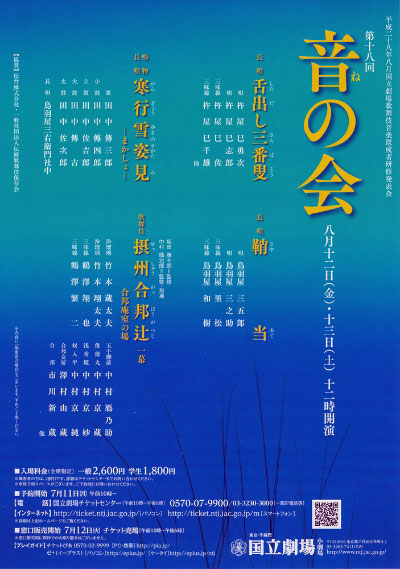 |
| Dates | 17 ~ 21 August 2016 (Chigyokai/Kabukikai) |
| Program |
Onna Kurumabiki |
| Comments |
22nd edition of the common program for 2 associations, the Chigyokai (the Young Fishes Association) and the Kabukikai (the Kabuki Association), which stars stars' disciples in the leading roles of all the items in the program.
|
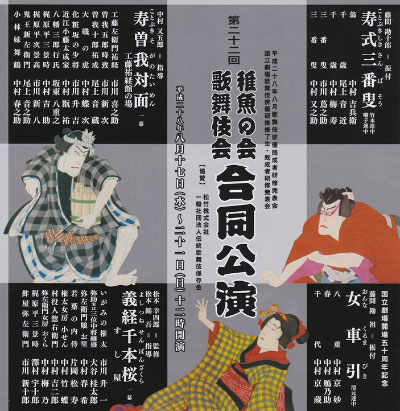 |
| Dates | 24 ~ 25 August 2016 (S˘ch˘kai) |
| Program |
|
| Casting |
Nakamura Kash˘, Nakamura Tanenosuke, Nakamura Baishi, Nakamura Yonekichi, Nakamura Umemaru |
| Comments |
2nd edition of the S˘ch˘kai (literally "the Two Butterflies Association"), which stars Nakamura Kash˘ and his brother Nakamura Tanenosuke. Nakamura Shibajaku, Nakamura Matagor˘, Ichikawa Somegor˘ and Onoe Sh˘roku are the guest stars of this program.
|
|
|||
| Dates | 29 July ~ 1 August 2016 (Sora no Kai) | ||
| Program | |||
| Casting |
Kataoka Matsujűr˘, Kataoka Senjir˘, Kataoka Senju |
||
| Comments |
The 2nd gala of the Sora no Kai (literally 'Sky Society'), in ďsaka at the Kintetsu Art Kan, which stars Kataoka Matsujűr˘, Kataoka Senjir˘ and Kataoka Senju, 3 disciples of the Matsushimaya guild. Sora no Kai literally means "Sky Association". "Ise Sangű Kami no Nigiwai", based on a famous Kamigata rakugo story, is a newly-created drama. It is staged under the supervision of Kataoka Hidetar˘ and the dance master Yamamura Tomogor˘ III. These performances are entitled Abeno Kabuki (Abeno is the name of a famous district in ďsaka). |
||
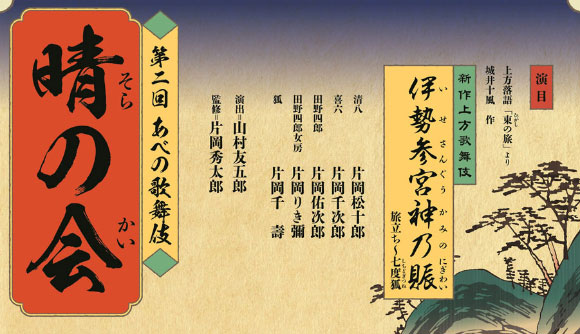 |
| National Bunraku Theatre (ďsaka) |
| Dates | 24 ~ 25 August 2016 (Kamigata Kabukikai) |
| Program |
Goj˘bashi |
| Comments |
26th edition of the Kamigata Kabukikai (the Kamigata Kabuki Association), a summer program in ďsaka which stars Kamigata Kabuki stars' disciples in the leading roles of all the items, with the guidance of Kataoka Nizaemon and Kataoka Hidetar˘.
|
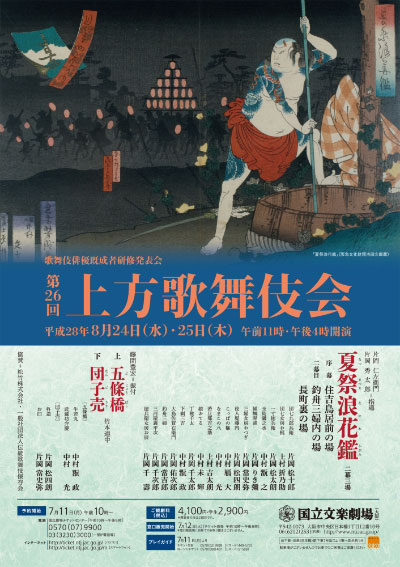 |
| National N˘ Theatre (T˘ky˘) |
| Dates | 8 August 2016 (Sh˘ no Kai) |
| Program |
Kakitsubata Sukeroku |
| Comments |
3rd edition of the Sh˘ no Kai, a gala program which stars Nakamura Tomijűr˘ V's son Nakamura Takanosuke. Nakamura Takanosuke performs in "Kakitsubata" and "Sukeroku". His sister Watanabe Aiko performs in "Shiokumi". The long-time NHK announcer Kasai Seiji is the guest in charge of all the talking. |
|
|
| Contact | Main | Top | Updates | Actors | Plays | Playwrights | Programs | Links | FAQ | Glossary | Chronology | Illustrations | Prints | Characters | Derivatives | Theaters | Coming soon | News |
